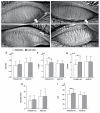Morphological and Functional Changes of Meibomian Glands in Pediatric and Adult Patients with Allergic Conjunctivitis
- PMID: 35268518
- PMCID: PMC8911235
- DOI: 10.3390/jcm11051427
Morphological and Functional Changes of Meibomian Glands in Pediatric and Adult Patients with Allergic Conjunctivitis
Abstract
Allergic conjunctivitis (AC) is one of the most common ocular disorders in clinical practice and is associated with meibomian gland dysfunction. This study aimed to explore the morphological and functional changes of meibomian glands (MGs) in pediatric and adult patients with AC and to analyze their potential predictors. In our prospective, observational cohort study, a total of 59 patients with AC were enrolled, with 30 patients aged ≤16 years in the pediatric group and 29 patients in the adult group. All patients underwent examinations at baseline and last visit when the complete resolution of conjunctival papillae was identified. An automatic MG analyzer was used to measure the morphological and functional parameters of MGs, including their area ratio (GA), tortuosity index (TI), and signal index (SI). Two groups were comparable at baseline in terms of characteristics and MG parameters (p > 0.05). The morphological (length, square, and GA) and functional MG parameters (SI) of AC patients significantly improved in the pediatric group after treatment (all p < 0.05), but not in the adult group. The change in the GA correlated with age, sex, GA, TI, and SI at baseline (all p < 0.05). Age (p = 0.001) and GA (p < 0.001) at baseline were predictors of an improvement in the GA of MGs. The findings showed that the structure and function of MGs in pediatric patients with AC seem to improve after the conjunctival papillae disappear, but not in adult patients.
Keywords: allergic conjunctivitis; child; dry eye; meibomian glands; tear film.
Conflict of interest statement
The authors declare no conflict of interest.
Figures




References
Grants and funding
LinkOut - more resources
Full Text Sources

